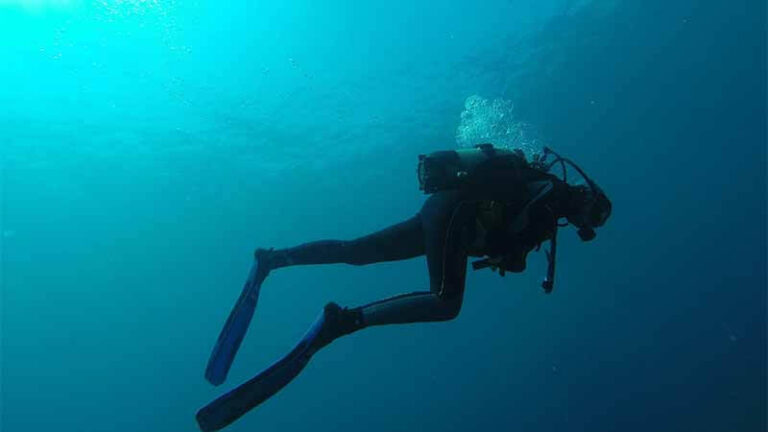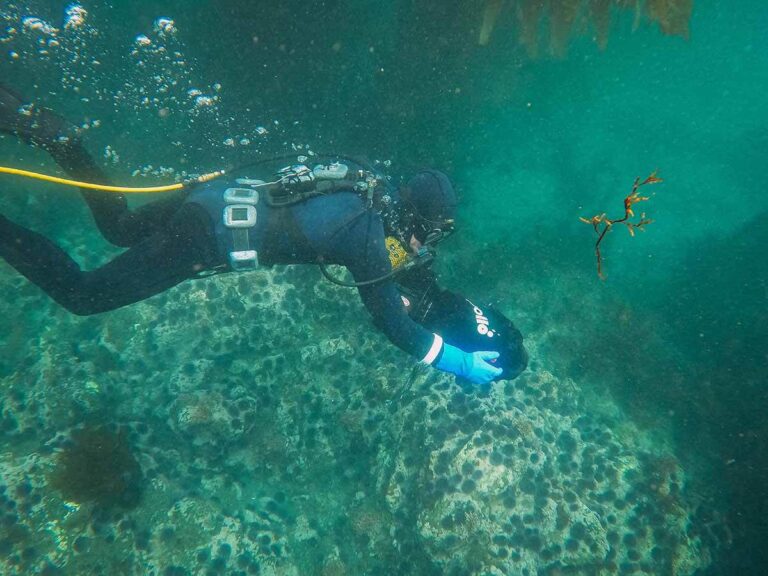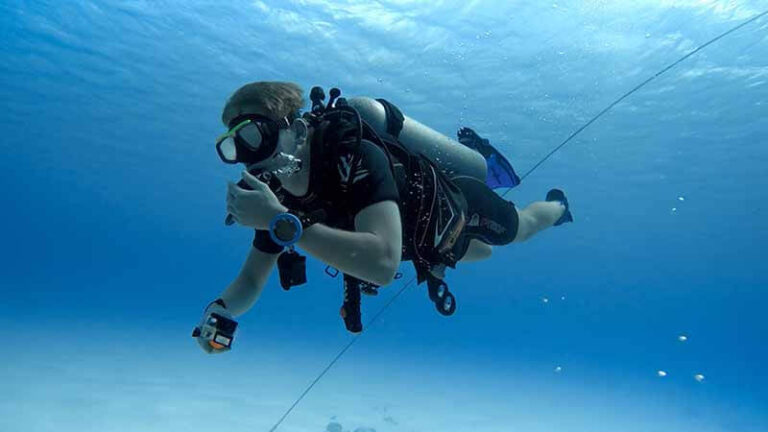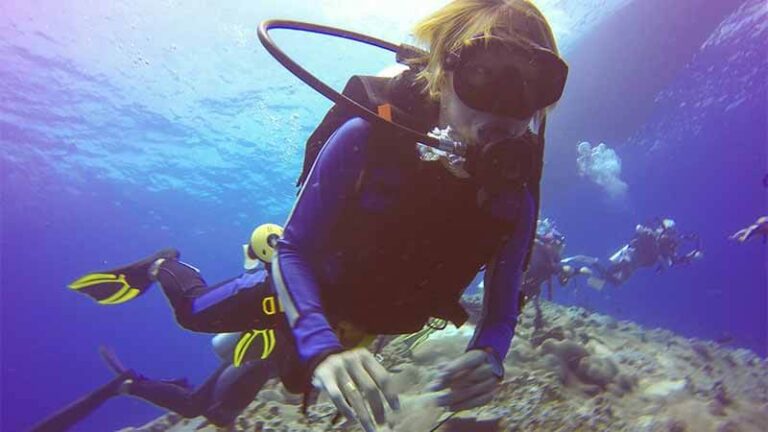Scuba Diving Fins VS Snorkeling Fins
Fins are essential in improving the overall enjoyment and efficiency of water sports such as scuba diving and snorkeling. These specialized devices are crucial for swimmers and divers because they boost underwater propulsion, maneuverability, and control. Human-designed fins allow people to navigate through water with more ease and less effort by emulating the movement of marine animals’ fins.
Fins improve a swimmer’s or diver’s speed and agility, allowing them to traverse longer distances and explore the underwater world for longer periods of time. Having the proper fins can make a significant difference in comfort and performance during scuba diving or snorkeling, where maintaining a steady pace and navigating underwater areas is critical.
Introduction to Scuba Diving Fins and Snorkeling Fins
Fins are essential in improving the overall enjoyment and efficiency of water sports such as scuba diving and snorkeling. These specialized devices are crucial for swimmers and divers because they boost underwater propulsion, maneuverability, and control. Human-designed fins allow people to navigate through water with more ease and less effort by emulating the movement of marine animals’ fins.
Fins improve a swimmer’s or diver’s speed and agility, allowing them to traverse longer distances and explore the underwater world for longer periods of time. Having the proper fins can make a significant difference in comfort and performance during scuba diving or snorkeling, where maintaining a steady pace and navigating underwater areas is critical.
Snorkeling fins, on the other hand, are designed for surface swimming and leisurely snorkeling. Snorkelers use these fins to effortlessly push themselves across the water’s surface while studying the marine life beneath. Snorkeling fins are lighter, more flexible, and designed for surface swimming, making them perfect for casual and recreational snorkeling excursions.
The primary goal of this blog post is to conduct a comparison between scuba diving fins with snorkeling fins. This article intends to assist readers make an informed decision when selecting the proper type of fins for their individual aquatic adventures by studying their distinct qualities, capabilities, and advantages.
Understanding the differences between these two types of fins will allow readers to choose the best equipment that aligns with their interests, skill levels, and water activity preferences, whether they are aspiring scuba divers looking to explore the depths or casual snorkelers interested in observing marine life near the surface.
Scuba Diving Fins
Scuba diving fins are specialized underwater propulsion devices worn by divers on their feet to aid mobility in the water. They are essential pieces of diving equipment and come in a variety of forms and designs to accommodate different diving tastes and environments. Scuba diving fins, as opposed to standard swim fins used for surface swimming, are designed to work well in the depths, where divers must navigate currents and a variety of underwater situations.
Key Features and Design Elements
Scuba diving fins include a number of significant features and design components that set them apart from other types of fins. They are usually longer and more robust, with a larger surface area for more push with each kick. Divers can travel through the water with less effort because of the bigger blade design, which saves energy during long dives.
Furthermore, to withstand the rigors of underwater operation and resist damage from rocks, reefs, or other impediments, the blades are typically made of robust materials such as rubber or high-quality plastics.
Another important feature of scuba diving fins is the foot pocket. Divers must have a comfortable and secure fit to avoid blisters or foot cramps during long dive sessions. Many diving fins have adjustable straps or buckles, allowing divers to alter their fit for enhanced comfort and performance.
How Scuba Diving Fins Assist in Underwater Propulsion
Scuba diving fins push divers through the water by combining forceful thrust with effective water channeling. When divers kick, the wide surface of the blade displaces water backward, providing a forward force that propels the diver in the opposite direction.
This propulsion system allows divers to glide smoothly through the water column while consuming the least amount of energy, allowing them to travel longer distances and explore varied underwater ecosystems.
Types of Scuba Diving Fins
There are multiple types of scuba diving fins on the market, each with unique features to accommodate different diving techniques and preferences. Some examples of frequent types are:
- Split Fins: Split fins have a split down the blade’s center that looks like a “V” form. They are intended to reduce resistance during the upstroke and to produce a more efficient kicking action that requires less effort from the diver.
- Paddle Fins: Paddle fins feature a strong blade that is free of splits. They provide greater rigidity and are used by divers who desire a stronger, more forceful kick for better control in difficult situations.
- Channel Fins: Channel fins have unique channels or vents on the surface of the blade. These channels control the flow of water, boosting the overall efficiency of the fin and giving more thrust with less effort.
Advantages of Scuba Diving Fins for Extended Diving Sessions
Scuba diving fins are specifically designed to improve a diver’s performance and comfort when submerged for lengthy periods of time. The following are the primary benefits:
- Improved Propulsion: Scuba diving fins’ bigger blade surface and efficient construction provide superior propulsion, allowing divers to move effortlessly through the water even in the presence of currents.
- Less tiredness: Because of their efficient underwater propulsion, scuba diving fins greatly minimize tiredness, allowing divers to extend their diving sessions without putting undue strain on their legs and muscles.
- Versatility: Scuba diving fins can be used for a variety of underwater activities, from leisurely reef exploration to deep-sea diving adventures, making them an excellent choice for divers of all skill levels.
- Durability: Scuba diving fins are designed with strong materials and construction to handle the rigors of underwater conditions, assuring long-lasting performance and durability.
Snorkeling Fins
Snorkeling fins are specialized swimming gear that snorkelers use on their feet to improve their surface swimming and snorkeling experiences. Snorkeling fins are meant for leisurely exploration at the water’s surface, as opposed to scuba diving fins, which are developed for efficient propulsion in deeper waters. These fins allow snorkelers to move through the water effortlessly, view marine life, and enjoy the underwater beauty while conserving energy.
Key Features and Design Elements
Snorkeling fins are designed with specialized features and parts to meet the needs of surface swimmers. They are shorter and lighter than scuba diving fins, making them more appropriate for surface-level activities. Snorkeling fin blades are flexible and sensitive, giving appropriate thrust with a relaxed kicking motion.
Snorkeling fin foot pockets are often composed of soft and comfortable materials, ensuring a secure fit without causing discomfort or chafing during prolonged use. Some snorkeling fins have adjustable straps or buckles to ensure a secure fit and to accommodate varied foot sizes.
How Snorkeling Fins Enhance Surface Swimming and Snorkeling Experiences
Snorkeling fins help to improve surface swimming and snorkeling experiences in a variety of ways. For starters, they provide improved propulsion, allowing snorkelers to travel through the water more effectively and with less effort. The extra push produced by the fins allows snorkelers to traverse greater distances, explore diverse places, and easily track marine creatures.
Second, snorkeling fins allow users to maintain a steady and pleasant body position during snorkeling. Snorkelers can use fins to keep their bodies near the water’s surface, decreasing pressure on their neck and back muscles. This stance allows for extended snorkeling excursions without becoming fatigued.
Furthermore, snorkeling fins improve maneuverability by allowing users to quickly reverse direction and navigate through shallow waters, reefs, or rocky regions without harming the underwater environment.
Types of Snorkeling Fins
Snorkeling fins come in a variety of styles, each tailored to the tastes and comfort levels of the user. The following are some examples of snorkeling fins:
- Full-Foot Fins: Like a shoe, full-foot fins enclose the entire foot, creating a snug and secure fit. Because they are lightweight and easy to slip on and off, these fins are great for warm-water snorkeling and surface swimming.
- Adjustable Strap Fins: These fins have an open-heel design that allows them to be used over water shoes or bare feet. The adjustable straps allow users to get a tailored fit, making them appropriate for a wide range of foot sizes and adding comfort.
Advantages of Snorkeling Fins for Casual Snorkelers and Leisurely Explorations
Snorkeling fins provide various benefits to recreational snorkelers and those looking for leisurely explorations:
- Effortless Swimming: The design of snorkeling fins allows for effortless propulsion, making them suitable for users of all ages and fitness levels. Snorkelers may glide effortlessly over the water and enjoy extended snorkeling sessions even with minimal kicking effort.
- Comfort and Stability: Snorkeling fins keep the snorkeler close to the surface of the water, decreasing strain on the body and allowing for a more comfortable and enjoyable experience. The comfy foot pocket and lightweight design allow users to snorkel for a lengthy period of time.
- Easy Maneuvrability: Snorkeling fins improve users’ maneuverability, allowing them to easily follow marine life, explore reefs, and change direction without disrupting the underwater environment.
- Travel-Friendly: Snorkeling fins are easy to pack and travel with due to their lightweight and small form, making them an ideal choice for vacation snorkeling or exploring different snorkeling areas.
Differences Between Scuba Diving Fins and Snorkeling Fins
Blade length and stiffness
The length and rigidity of fin blades have a considerable impact on underwater maneuverability and speed. Scuba diving fins are typically longer and more rigid than snorkeling fins. The larger surface area of the longer blade generates more push, allowing scuba divers to travel more efficiently over deeper waters and against strong currents. The rigidity of scuba diving fins improves reactivity, giving divers precise control and power during kicks.
Snorkeling fins, on the other hand, have shorter and more flexible blades. This form is suited for surface swimming and leisurely snorkeling where speed and agility are not required. Snorkelers can swim comfortably at the water’s surface, observing marine life without overexerting themselves, thanks to the shorter and more flexible blade.
Heel type
Another distinction between scuba diving and snorkeling fins is the heel type. Scuba diving fins with an open-heel design often cover only the front area of the foot, leaving the heel exposed.
This design allows divers to increase warmth and protection by wearing booties or neoprene socks, making them suited for cold-water diving circumstances. Divers can establish a secure and customizable fit using open-heel fins’ adjustable straps.
Snorkeling fins, on the other hand, are often full-foot designs, with the foot pocket covering the entire foot like a shoe. These fins are designed for warm-water snorkeling and surface swimming where foot protection is not a priority. The full-foot design provides a comfortable fit and is simple to slip on and off, making them ideal for casual snorkelers in tropical settings.
Material and construction
Scuba diving and snorkeling fins are made from a variety of materials, which affect their performance and longevity. Scuba diving fins are frequently made of durable materials such as high-quality rubber or sophisticated polymers.
These materials provide the stiffness and strength required to survive the rigors of deep-sea diving, such as swimming against strong currents or navigating rocky areas. The sturdy design ensures that scuba diving fins can withstand repeated use without succumbing to wear and tear.
Snorkeling fins are often made of lighter and more flexible materials because they are suited for less demanding surface-level activities. Because they are not subjected to the same stringent circumstances as scuba diving fins, they emphasize comfort and convenience of use. While these materials are still sturdy for casual snorkeling, they may not hold up as well in more difficult diving scenarios.
Weight and buoyancy
Weight and buoyancy are important factors in various water activities, determining the use of fins. Due to their strong design and the necessity for increased thrust in deeper depths, scuba diving fins are often heavier. The weight assists divers in maintaining stability and control in a variety of underwater circumstances, resulting in a more efficient and controlled diving experience.
Snorkeling fins, on the other hand, are meant to be lightweight, allowing snorkelers to stay closer to the water’s surface while conserving energy during leisurely explorations. The lighter weight allows for effortless surface swimming and improves overall snorkeling comfort.
Kick technique
Due to their various shapes, scuba diving fins and snorkeling fins assist diverse swimming styles. Scuba diving fins are built to withstand more intense and intentional kicks, which are required for efficient propulsion during deeper dives. Divers frequently employ a flutter kick or frog kick technique to produce power and retain control underwater, leveraging the stiffness and length of the fins.
Snorkeling fins, on the other hand, are designed for a more relaxed and leisurely swimming manner. To maintain a comfortable pace near the water’s surface, snorkelers typically use a modified flutter kick or a mild scissor kick. Snorkeling fins’ shorter and more flexible blades provide enough push for surface swimming without demanding too much effort.
Similarities Between Scuba Diving Fins and Snorkeling Fins
Enhancing Propulsion and Minimizing Effort
Despite their differences in design and intended application, both scuba diving and snorkeling fins have the same goal: to improve propulsion and reduce effort during aquatic activities. Both types of fins are precisely designed to allow swimmers, whether diving or snorkeling, to move through the water more efficiently and with less effort.
Scuba diving fins and snorkeling fins provide higher force by increasing the surface area of each kick, propelling the user ahead with less effort. This effective propulsion system is especially useful for traveling longer distances, exploring varied underwater settings, and observing marine life without tiring.
Materials used for Both Types of Fins
Another feature that scuba diving fins and snorkeling fins have in common is the use of similar materials in their fabrication. While the design may vary, both types of fins are typically made of robust materials that can survive the rigors of underwater settings.
Scuba diving and snorkeling fins are frequently made of high-quality rubber and sophisticated polymers. These materials provide the appropriate balance of strength, flexibility, and wear and tear resistance, guaranteeing that the fins can sustain regular use in a variety of aquatic environments.
Fit and Sizing Considerations
Scuba diving fins and snorkeling fins both require a comfortable and secure fit to work optimally. Inadequately fitting fins can cause discomfort, blisters, and decreased efficiency in the water, negatively compromising the user’s entire experience.
In both circumstances, the shape of the foot pocket is critical for ensuring a snug fit around the foot. Whether it’s a full-foot snorkeling fin design or an open-heel scuba diving fin with adjustable straps, the idea is to provide customers with a customizable fit that provides stability and prevents the fins from slipping off during use.
Furthermore, optimal fin sizing is crucial for performance optimization. Too-loose fins may cause the foot to slide within the pocket, resulting in a loss of force and control while swimming or diving. Too-tight fins, on the other hand, might cause irritation and restricted blood flow.
Choosing the Right Fins for Your Adventure
Factors to Consider When Selecting Fins
Several important criteria should be considered while selecting the proper fins for your underwater excursion to ensure a comfortable and happy experience. These elements are very important since they influence the overall performance and usability of the fins for your specific demands.
Skill Level and Experience
Your skill level and expertise in water activities such as scuba diving or snorkeling are important factors to consider while choosing fins. Shorter, more flexible fins may be better suited to the needs of beginners or less experienced individuals. These fins are easier to control and require less effort to propel, making them excellent for increasing confidence and exploring shallower waters.
In more difficult situations, experienced divers or snorkelers may benefit from longer, stiffer fins that provide greater thrust and control. These advanced fins are designed to accommodate the specialized techniques and needs of experienced underwater enthusiasts, improving their performance during longer dives or more daring explorations.
Frequency of Use
Another important consideration is how frequently you intend to utilize the fins. If you are a frequent diver or snorkeler, investing in high-quality, durable fins made of strong materials is crucial to ensure they can endure repeated use and last for a long time. These fins may have a greater initial cost, but because of their lifespan, they may be more cost-effective in the long run.
In contrast, casual snorkelers or those trying out water activities for the first time may prefer more affordable fins without sacrificing comfort and fit. However, even if you only use the fins occasionally, a good fit is essential to avoid discomfort and distraction during your excursion.
Water Conditions and Dive/Snorkel Locations
The precise water conditions and dive/snorkel places you intend to explore are other important considerations when choosing the proper fins. Scuba diving fins with a durable construction and longer blades, for example, maybe more appropriate if you intend to dive in places with strong currents or navigate through rocky environments. These features improve control and propulsion in difficult conditions.
Shorter and more flexible snorkeling fins can provide adequate propulsion and flexibility of movement for leisurely snorkeling in calm, shallow waters. Furthermore, if you plan to travel and visit different snorkeling locations, compact and lightweight fins may be preferable due to their portability and convenience.
The Importance of Trying Fins Before Buying
It is critical to try on the fins before purchasing them to ensure a perfect fit and comfort. Each person’s foot form and size differ, and what works well for one person may not work well for another. Wear the right water socks or booties for diving or snorkeling when trying on fins to simulate the actual fit in the water.
Pay close attention to any pressure areas or discomfort, as these could cause problems with prolonged use. Walk around and replicate swimming movements if possible to get a feel for how the fins work in the water.
Recommendations for Different Scenarios
The type of fins you choose will depend on the precise aquatic activities and scenarios you intend to participate. Here are some suggestions for various scenarios:
- Leisure Snorkeling: Shorter, lighter, and more flexible snorkeling fins are suitable for casual snorkelers exploring calm and shallow waters. These fins provide enough propulsion and mobility for casual underwater exploring.
- Advanced Scuba Diving: Longer, stiffer scuba diving fins may aid experienced scuba divers traveling into deeper waters or challenging situations. These fins offer improved thrust and control, making them ideal for long dives and maneuvering against currents.
- Warm-water Travel Snorkeling: If you want to snorkel in tropical locations, tiny and lightweight travel snorkeling fins are an excellent alternative. These fins are designed for ease of packing and portability, making them ideal for visiting different snorkeling locations.
- Cold-water Diving: For increased warmth and protection in colder seas, open-heel scuba diving fins with the option of wearing neoprene socks or booties are recommended. These fins are more adaptable and may be altered to accommodate varying water temperatures.
Maintenance and Care
Proper Cleaning and Storage of Fins
Proper cleaning and storing of your scuba diving or snorkeling fins is critical to extending their lifespan and ensuring optimal performance. Rinse the fins with fresh water after each use to eliminate saltwater, sand, or debris that could cause damage over time. When cleaning, avoid using harsh chemicals or abrasive materials, as these may degrade the fin’s components.
After carefully rinsing the fins, allow them to air dry entirely before storing them. Storing damp or wet fins might promote mold or bacterial growth, jeopardizing their integrity. To prevent fading or warping of the materials, keep them in a cool, dry place away from direct sunlight.
Avoiding Damage and Extending the Lifespan of Your Fins
Handle your fins with care both in and out of the water to increase their lifespan and prevent damage. Walking on rough terrain while wearing fins can result in abrasions or scratches on the blade. To avoid stressing the foot pocket or straps, use slow and deliberate movements when putting on or removing the fins.
Use a protective bag or cover when shipping your fins to protect them from potential impacts or friction during travel. Avoid leaving the fins in hot or cold environments, since this might cause material degradation or warping.
Furthermore, keep your fins away from sharp items and chemical substances that could harm them. Inspect the fins on a regular basis for signs of wear, cracks, or loose components, and rectify any concerns as soon as possible to prevent further damage.
How to Deal with Common Issues
- Foot Chafing: Foot chafing can occur if the fins do not fit properly or if the foot pocket scrapes against the flesh after lengthy use. To avoid chafing, use fins that are the proper size for you and provide a comfortable fit without being too tight. Wearing neoprene socks or fin socks can offer padding and reduce friction, reducing foot chafing.
- Strap Adjustment: For fins with adjustable straps, achieving a secure and comfortable fit is critical to avoiding pain or slippage during aquatic activities. Adjust the straps to fit your foot size and comfort level, making sure they are snug but not too tight. In the water, test the fit to verify the straps stay in place and provide a secure hold.
If your straps or buckles become damaged, try replacing them with matching spare parts provided by the manufacturer or seek assistance from a competent diving shop.
Addressing these frequent difficulties as soon as possible, as well as exercising proper maintenance and care, will help maintain your fins in outstanding condition, allowing you to have many more fun diving and snorkeling trips.
Remember that well-maintained fins not only improve your underwater experiences but also add to your safety and comfort when participating in aquatic sports.
Conclusion
Finally, the selection of fins for your aquatic adventures is a critical decision that has a considerable impact on your whole experience and performance underwater. Whether you are a seasoned scuba diver exploring the depths or a casual snorkeler observing marine life near the surface, choosing the proper fins for your water activity is critical.
Scuba diving fins and snorkeling fins, as mentioned throughout this blog post, have distinct characteristics and design components that are ideal for their particular functions. Understanding these distinctions allows you to make an informed decision, ensuring that your fins complement your skills, preferences, and intended situations.
Furthermore, we cannot emphasize enough how important it is to prioritize comfort, performance, and fit when selecting your fins. A secure and comfortable fit lowers the chance of discomfort, foot chafing, and slipping, allowing you to concentrate on the fun of underwater exploration. Investing in high-quality fins made of sturdy materials increases their longevity and assures that you can rely on them for a plethora of unforgettable dives and snorkeling excursions.
Above all, we urge you to dive into the enthralling underwater world responsibly and with appropriate equipment. Respecting marine life and vulnerable ecosystems is critical for conserving our oceans’ beauty and biodiversity. To avoid any harmful impact on the ecosystem, keep in mind that underwater exploration necessitates mindfulness and adherence to appropriate diving and snorkeling techniques.
Take the time to learn about local restrictions before engaging in any aquatic activity, dive or snorkel with a friend, and avoid harming or disturbing marine life. Perform any essential safety checks and ensure that your equipment, including fins, is in good working order.





